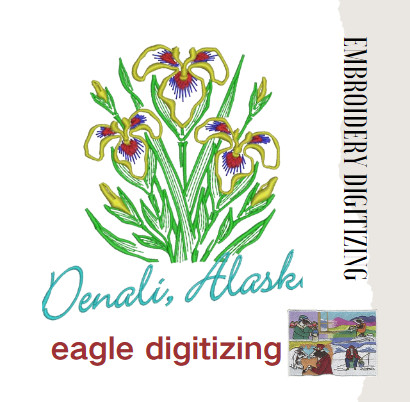Embroidery Secrets: No More Loose Threads!
Embroidery digitizing is a meticulous art that requires precision and attention to detail. One of the most common challenges faced by embroiderers is dealing with loose threads. These pesky issues can detract from the overall quality and durability of your designs. Understanding the intricacies of loose threads, their causes, and how to prevent them is essential for anyone looking to master the craft of embroidery digitizing.
Understanding Loose Threads
What Are Loose Threads?
Loose threads in embroidery refer to strands that protrude from the fabric, creating a messy and unprofessional appearance. They can occur at various stages of the embroidery process and can be caused by several factors, including improper tension, incorrect threading, or inferior materials.
Common Causes of Loose Threads in Embroidery
Loose threads can stem from a myriad of issues, such as poor-quality thread, improper hooping techniques, or incorrect thread tension. Other common culprits include worn-out needles, incorrect stabilizer usage, and machine maintenance issues. Identifying the root cause is the first step in resolving and preventing loose thread problems.
Importance of Tight Threads in Embroidery
Impact on Design Quality
Tight threads are crucial for maintaining the integrity and aesthetics of your embroidery designs. Loose threads can distort the design, resulting in uneven stitching and a lack of detail. Tight threads ensure that each stitch is precisely placed, creating a crisp and clean finish.
Longevity of Embroidered Pieces
The durability of embroidered items significantly depends on the tightness of the threads. Loose threads are more prone to snagging and breaking, which can lead to unraveling and a shorter lifespan for the piece. Tight threads, on the other hand, help ensure that the embroidery withstands wear and tear over time.
Choosing the Right Materials
Selecting High-Quality Threads
Investing in high-quality threads is paramount. Superior threads are less likely to fray, break, or cause tension issues. They provide a smoother and more consistent stitching experience, resulting in a polished final product.
Importance of Fabric Choice
The fabric you choose can significantly impact thread tension and overall stitch quality. Fabrics that are too stretchy or flimsy can cause loose threads, while more stable fabrics provide a solid foundation for your designs.
Needles and Their Role in Preventing Loose Threads
Using the correct needle for your project is essential. Needles that are too large or too small can cause tension issues and result in loose threads. Regularly changing your needle and selecting the appropriate size and type for your fabric and thread can prevent many common problems.
Proper Thread Tension
How to Adjust Thread Tension
Thread tension adjustment is a critical skill for embroiderers. It involves fine-tuning the tightness of the upper and bobbin threads to ensure they interlock correctly within the fabric. This balance is essential for preventing loose threads and achieving a smooth stitch.
Identifying Correct Tension Settings
Correct tension settings vary depending on the machine, thread, and fabric. A properly balanced tension will result in stitches that lie flat on the fabric without puckering or looping. Testing on a scrap piece of fabric before starting your main project can help determine the ideal settings.
Consequences of Incorrect Tension
Incorrect tension can lead to a range of problems, from loose threads to broken needles. It can cause uneven stitching, puckering, and thread breakage, all of which compromise the quality of your embroidery. Understanding and adjusting thread tension is vital for professional results.
Machine Maintenance and Calibration
Regular Cleaning and Maintenance Tips
Routine maintenance is crucial for preventing loose threads and other issues. This includes regularly cleaning your machine to remove lint and debris, oiling moving parts, and checking for wear and tear on components.
How to Calibrate Your Embroidery Machine
Calibration ensures that your machine operates correctly and maintains consistent tension. Follow your machine's manual for calibration procedures, and consider professional servicing if needed.
Signs Your Machine Needs Maintenance
Common signs that your machine requires maintenance include unusual noises, skipped stitches, and consistent thread breaks. Regular maintenance can prevent these issues and ensure smooth operation.
Hoop Techniques for Tight Stitches
Proper Hooping Techniques
Proper hooping is essential for maintaining fabric stability during embroidery. The fabric should be taut but not overly stretched, and the hoop should be securely tightened to prevent movement.
Types of Hoops and Their Uses
Different hoops are designed for various fabrics and projects. Understanding the strengths and weaknesses of each type can help you choose the right hoop for your specific needs.
Avoiding Hoop Burn
Hoop burn occurs when the fabric is overly compressed by the hoop, leaving marks. To prevent this, use the appropriate hoop size and avoid overtightening.
Stabilizers: The Unsung Heroes
Choosing the Right Stabilizer
Stabilizers support the fabric during embroidery, preventing puckering and distortion. Selecting the right stabilizer depends on your fabric and design.
How to Use Stabilizers Effectively
Proper use of stabilizers involves securing them correctly and choosing the right type for your fabric. Cut-away, tear-away, and water-soluble stabilizers each have specific applications.
Types of Stabilizers for Different Fabrics
Different fabrics require different stabilizers. For instance, stretchy fabrics often need a cut-away stabilizer, while more stable fabrics might only require a tear-away option.
Digitizing Tips for Tight Stitches
Best Practices in Digitizing for Tight Stitches
Effective digitizing ensures that stitches are placed optimally, reducing the likelihood of loose threads. This includes planning the stitch path and density carefully.
Avoiding Common Digitizing Mistakes
Common mistakes in digitizing include overly dense stitching, improper underlay, and inefficient stitch paths. Avoiding these can enhance stitch tightness and overall design quality.
Using Software Tools to Ensure Tight Stitches
Embroidery software often includes tools to help manage stitch density and tension. Utilizing these features can assist in achieving tight, professional stitches.
Thread Management Techniques
Proper Thread Storage Solutions
Proper storage helps maintain thread quality and prevent tangling. Store threads in a cool, dry place, and consider using thread racks or boxes.
Using Thread Nets and Spool Caps
Thread nets and spool caps prevent threads from unraveling and tangling during use, ensuring a smoother embroidery process.
Preventing Thread Breakage and Tangles
Preventing thread breakage involves using high-quality thread, proper tension, and regular machine maintenance. Avoiding tangles can be achieved with proper storage and handling techniques.
Needle Selection and Care
Choosing the Right Needle for Your Project
The right needle depends on your fabric and thread. Consider factors such as needle size, type, and point when selecting needles.
How Often to Change Needles
Regularly changing needles prevents wear and tear that can lead to loose threads and other issues. A general rule is to change your needle every 8-10 hours of embroidery.
Caring for Your Needles
Proper needle care includes storing them correctly and replacing them when they show signs of wear. Dull or bent needles can cause a range of problems, including loose threads.
Thread Path and Tension Discs
Ensuring Correct Thread Path
Ensuring the thread follows the correct path through the machine is crucial for maintaining tension. Misthreading can lead to loose threads and other issues.
Cleaning and Maintaining Tension Discs
Regularly cleaning tension discs prevents debris buildup that can affect tension. Use a soft brush or cloth to clean the discs gently.
Signs of Worn-Out Tension Discs
Worn-out tension discs can cause inconsistent tension and loose threads. Signs include visible wear, uneven tension, and frequent thread breaks.
Bobbin Care and Management
Winding Bobbins Correctly
Correctly winding bobbins ensures even tension and smooth stitching. Avoid overfilling bobbins and ensure they are wound evenly.
Types of Bobbins and Their Impact on Tension
Different bobbins can affect tension. Metal and plastic bobbins each have unique characteristics, and using the correct type for your machine is essential.
Maintaining Bobbin Cases and Areas
Regular maintenance of bobbin cases and areas prevents lint buildup and other issues that can affect tension. Clean these areas frequently to ensure smooth operation.
Handling Thread Breaks
Quick Fixes for Thread Breaks
When thread breaks occur, quick fixes include rethreading the machine, checking for tangles, and adjusting tension settings.
Preventative Measures for Thread Breakage
Preventative measures include using high-quality thread, proper tension, and regular maintenance. Ensuring the correct thread path also helps prevent breaks.
Adjusting Machine Settings to Reduce Breaks
Adjusting machine settings, such as tension and speed, can help reduce thread breaks. Testing these settings on scrap fabric can help find the optimal configuration.
Test Runs and Samples
Importance of Test Runs
Test runs are crucial for identifying potential issues before starting your main project. They help you adjust settings and ensure optimal stitch quality.
Analyzing Test Run Results
Carefully analyze test run results to identify any issues, such as loose threads or incorrect tension. Make necessary adjustments based on these findings.
Making Adjustments Based on Test Runs
Adjust settings, such as tension and stitch density, based on test run results. This ensures that your final project will be free of loose threads and other issues.
Common Mistakes and How to Avoid Them
Overlooked Causes of Loose Threads
Commonly overlooked causes of loose threads include incorrect needle size, improper stabilizer use, and poor-quality thread. Addressing these can prevent many issues.
Simple Fixes for Common Mistakes
Simple fixes include adjusting tension, using the correct needle and stabilizer, and ensuring the proper thread path. These small adjustments can make a significant difference.
Learning from Past Projects
Reflecting on past projects and identifying what went wrong can help improve future work. Keep a journal of issues and solutions to refer back to.
Advanced Techniques for Tight Stitches
Using Underlay Stitches
Underlay stitches provide a foundation for your design, helping to secure the fabric and prevent loose threads. They are especially useful for large or dense designs.
Adjusting Stitch Density
Adjusting stitch density can help prevent loose threads. Too dense stitching can cause puckering, while too sparse stitching can lead to loose threads.
Exploring Different Stitch Types
Different stitch types, such as satin, fill and running stitches, each have unique characteristics. Exploring these can help you find the best option for your project.
Preventative Measures
Regular Maintenance Routine
Establishing a regular maintenance routine helps prevent many common issues, including loose threads. This includes cleaning, oiling, and checking machine components regularly.
Best Practices for Consistent Results
Following best practices, such as using high-quality materials and maintaining proper tension, helps ensure consistent results. Regular practice and learning also contribute to improvement.
Tips from Experienced Embroiderers
Experienced embroiderers often have valuable tips and tricks for preventing loose threads. Engaging with the embroidery community and learning from others can enhance your skills.
Understanding and preventing loose threads involves a combination of proper materials, correct tension, regular maintenance, and effective digitizing. Each element plays a crucial role in achieving professional results.
Embroidery is a craft that requires continuous learning and practice. Embrace the challenges and use each project as an opportunity to improve your skills.
Experienced embroiderers often have valuable tips and tricks for preventing loose threads. Engaging with the embroidery community and learning from others can enhance your skills. Eagle Digitizing provides digitizing services.
Understanding and preventing loose threads involves a combination of proper materials, correct tension, regular maintenance, and effective digitizing. Each element plays a crucial role in achieving professional results.
Embroidery is a craft that requires continuous learning and practice. Embrace the challenges and use each project as an opportunity to improve your skills.



